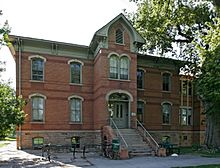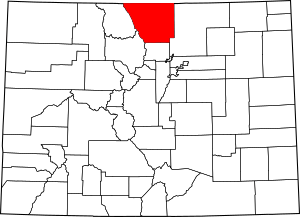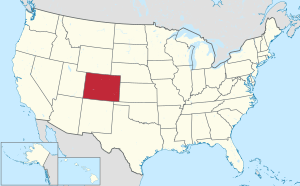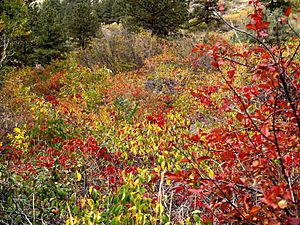Larimer County, Colorado facts for kids
Quick facts for kids
Larimer County
|
|
|---|---|

|
|

Location within the U.S. state of Colorado
|
|
 Colorado's location within the U.S. |
|
| Country | |
| State | |
| Founded | November 1, 1861 |
| Named for | William Larimer, Jr. |
| Seat | Fort Collins |
| Largest city | Fort Collins |
| Area | |
| • Total | 2,634 sq mi (6,820 km2) |
| • Land | 2,596 sq mi (6,720 km2) |
| • Water | 38 sq mi (100 km2) 1.4%% |
| Population
(2020)
|
|
| • Total | 359,066 |
| • Density | 138/sq mi (53/km2) |
| Time zone | UTC−7 (Mountain) |
| • Summer (DST) | UTC−6 (MDT) |
| Congressional districts | 2nd, 4th, 8th |
Larimer County is a cool place in the state of Colorado, USA. It's a county with a population of over 359,000 people, according to the 2020 census. The main city and county capital is Fort Collins. The county got its name from William Larimer, Jr., who also founded the city of Denver.
This county is part of the Fort Collins area, which is a busy metropolitan region. It's located at the northern end of the Front Range, which is a beautiful mountain area. It also touches the Colorado Eastern Plains and borders the state of Wyoming.
Contents
History of Larimer County
Larimer County was officially created in 1861. It was named after General William Larimer.
Unlike many parts of Colorado, which became famous for mining gold and silver, Larimer County grew mostly because of agriculture (farming). At first, people didn't think farming was possible here. The big mining rush mostly missed this area. But then, in the 1860s, people started using irrigation to bring water to the land. This helped many new settlers move in and start farms.
Early Days and Settlements

Long ago, before Europeans arrived, Native American tribes lived here. The Utes lived in the mountains, and the Cheyenne and Arapaho tribes lived in the flatter areas near the mountains.
In the early 1800s, French fur trappers came to the area. This was after the land became part of the United States through the Louisiana Purchase. In 1828, William H. Ashley traveled up the Cache la Poudre River. The river got its name because French trappers once hid gunpowder along its banks.
In 1848, a group of Cherokee people passed through the county. They were on their way to California using a path called the Cherokee Trail.
The area was officially opened for white settlers after a treaty with the Cheyenne and Arapaho in 1858. The first U.S. settlers arrived that same year. A man named Antoine Janis helped start the first U.S. settlement in this part of Colorado, called Colona. It was near what is now Laporte. Around the same time, Mariano Medina set up Fort Namaqua near present-day Loveland. The first irrigation canals for farming were built along the Poudre River in the 1860s.
In 1862, the settlement of Laporte became a stop on the Overland Stage Route. This route was created because of threats from Native Americans on other trails. Laporte was also chosen as the first county seat for the new Colorado Territory.
Later, the United States Army set up an outpost called Camp Collins near Laporte. But a big flood in 1864 destroyed it. The Army moved their post downstream, and this new spot became the town of Fort Collins. Fort Collins became the county seat in 1873.
In 1870, Fort Collins was chosen to be the home of the state agricultural college. This college later became Colorado State University.
Railroads Arrive
Early citizens of Larimer County really wanted railroads to come to their area. They were disappointed when the first major railroad bypassed them in 1870.
Finally, in 1877, the Colorado Central Railroad built a line through the county. This railroad connected towns like Golden and Longmont to Cheyenne. The town of Fort Collins even gave the railroad permission to build tracks right through the middle of town.
New towns like Loveland and Berthoud grew up along this new railroad line. They were named after important people from the Colorado Central Railroad. Another town, Wellington, was founded in 1903 and named after a railroad worker.
The Greeley, Salt Lake, and Pacific Railroad arrived a few years later. This railroad helped with quarrying stone, which became another important industry for the area. There was also a brief attempt at gold mining in a place called Manhattan, which is now a ghost town.
Farming and Water Projects
Farming in Larimer County got a big boost in 1902. This was when people started growing sugar beets. A large processing plant was built in Loveland by the Great Western Sugar Co.. This new industry brought many German immigrants from the Russian Empire to the county. They helped build new neighborhoods in Fort Collins.
Another major improvement for farming came in the 1930s. This was with the building of the Colorado Big Thompson Project. This project collected water from the western side of the mountains and brought it to Larimer and nearby counties. It also created a huge system to store and distribute water. This meant farmers could grow crops for much longer each year and irrigate much more land.
Geography
Larimer County covers a total area of about 2,634 square miles. Most of this is land (2,596 square miles), and a small part is water (38 square miles).
Neighboring Counties
- Laramie County, Wyoming (to the northeast)
- Weld County (to the east)
- Boulder County (to the south)
- Grand County (to the southwest)
- Jackson County (to the west)
- Albany County, Wyoming (to the northwest)
Main Roads
 Interstate 25
Interstate 25 U.S. Highway 34
U.S. Highway 34 U.S. Highway 36
U.S. Highway 36 U.S. Highway 87
U.S. Highway 87 U.S. Highway 287
U.S. Highway 287 State Highway 1
State Highway 1 State Highway 7
State Highway 7 State Highway 14
State Highway 14 State Highway 56
State Highway 56 State Highway 60
State Highway 60 State Highway 66
State Highway 66 State Highway 392
State Highway 392 State Highway 402
State Highway 402
Protected Natural Areas
Larimer County has many beautiful natural areas that are protected.
National Protected Areas
- Cache La Poudre Wilderness
- Comanche Peak Wilderness
- Neota Wilderness
- Rawah Wilderness
- Rocky Mountain National Park
- Roosevelt National Forest
State Protected Areas
- Boyd Lake State Park
- Lory State Park
Population Information
| Historical population | |||
|---|---|---|---|
| Census | Pop. | %± | |
| 1870 | 838 | — | |
| 1880 | 4,892 | 483.8% | |
| 1890 | 9,712 | 98.5% | |
| 1900 | 12,168 | 25.3% | |
| 1910 | 25,270 | 107.7% | |
| 1920 | 27,872 | 10.3% | |
| 1930 | 33,137 | 18.9% | |
| 1940 | 35,539 | 7.2% | |
| 1950 | 43,554 | 22.6% | |
| 1960 | 53,343 | 22.5% | |
| 1970 | 89,900 | 68.5% | |
| 1980 | 149,184 | 65.9% | |
| 1990 | 186,136 | 24.8% | |
| 2000 | 251,494 | 35.1% | |
| 2010 | 299,630 | 19.1% | |
| 2020 | 359,066 | 19.8% | |
| 2023 (est.) | 370,771 | 23.7% | |
| U.S. Decennial Census 1790–1960 1900–1990 1990–2000 2010–2020 |
|||
In 2000, there were about 251,494 people living in Larimer County. The population has grown a lot over the years, reaching 359,066 people by 2020.
Cities and Towns
Larimer County is home to several cities and towns.
Cities
Towns
- Berthoud (partially in Larimer and partially in Weld county)
- Estes Park
- Johnstown (partially in Larimer and partially in Weld county)
- Timnath
- Wellington
- Windsor (partially in Larimer and partially in Weld County)
Census-Designated Places
These are areas that are like towns but are not officially incorporated.
Unincorporated Communities
These are smaller communities that are not part of any city or town.
- Bellvue
- Buckeye
- Campion
- Cherokee Park
- Drake
- Glendevey
- Glen Haven
- Livermore
- Kinikinik
- Masonville
- Norfolk
- Pinewood Springs
- Pingree Park
- Poudre Park
- Rustic
- Virginia Dale
- Waverly
Ghost Towns
These are towns that used to exist but are now abandoned.
Education
Larimer County has several school districts:
- Park R3 (Estes Park)
- Poudre R1 (Fort Collins & surrounding area)
- Thompson R2-J (Berthoud & Loveland)
Fort Collins is also home to Colorado State University, a large public university.
Fun Things to Do
Larimer County offers many places for outdoor fun and learning.
Ancient Sites
- Lindenmeier Site: This is an important archaeological site where scientists found tools and evidence of early people.
National Trails
These are long trails perfect for hiking and exploring.
- Continental Divide National Scenic Trail
- Greyrock Mountain National Recreation Trail
- Mount McConnel National Recreation Trail
- Round Mountain National Recreation Trail
Bicycle Routes
There are many great paths for biking in the county.
- Cathy Fromme Prairie Natural Area
- Fossil Creek Trail
- Great Parks Bicycle Route
- Loveland's Recreation Trail
- Mason Trail
- Poudre River Trail
- Power Trail
- Spring Creek Trail
Scenic Drives
Enjoy beautiful views along these routes.
See also
 In Spanish: Condado de Larimer para niños
In Spanish: Condado de Larimer para niños



